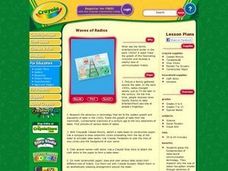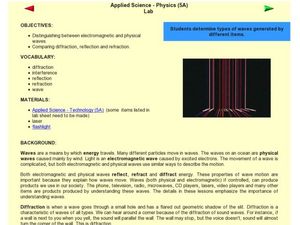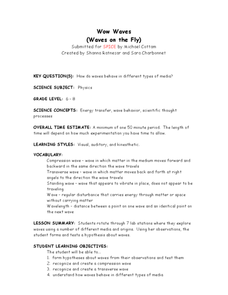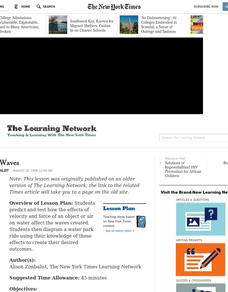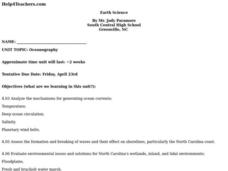Curated OER
What Causes Big Waves?
Students use the internet to research how waves are formed. Using construction paper, they create a diorama in which they can see how waves are formed and end. To end the lesson, they also discuss the causes and effects of earthquakes...
Curated OER
Standing Waves and Music: Suggested Demonstrations
There are four embedded links in this brief resource that take you to handouts or worksheets that assist young musicians in understanding standing sound waves. They'll play their instruments to show and then discuss different sound...
Curated OER
Waves of Radios
Students grasp the fundamentals of radio/sound communication technology. They research why the size of radios has gotten smaller through advances of technology...from large radio tubes through transistors through microchips. Students...
Curated OER
Electromagnetic and Physical Waves
High schoolers compare and contrast electromagnetic and physical waves. In this wave lesson, students discover that all waves reflect, refract, and diffract energy. High schoolers work in small groups to experiment with waves and...
Curated OER
Wow Waves (Waves on the Fly)
Students formulate hypotheses on wave behavior and test them. In this physics lesson, students compare and contrast transverse and compression waves. They determine the wavelength of transverse waves.
Curated OER
The Wonderful World of Waves (Wave Basics)
Young scholars define amplitude, wavelength, frequency, and period, calculate period given frequency, and calculate frequency given period, define crest and trough and locate both on diagram of wave, differentiate between latitudinal and...
Curated OER
Sounds like Science
Second graders create sound effects to produce a radio drama. In this sound lesson, 2nd graders read a book and provide the sound effects to transform it into a radio drama. They discuss sound and the shape of sound waves based on their...
Curated OER
Catch a Wave
Young scholars study low tides and how to calculate for fresh water. In this ocean science activity, students pretend they are stranded on an island and must calculate low tide in order to source the fresh water aquifer. Young scholars...
Curated OER
Making Waves
Students predict and test how the effects of velocity and force of an object or air on water affect the waves created. They diagram a water park ride using their knowledge of these effects to create their desired outcomes.
Curated OER
The Great Wave
Students investigate tsunamis and how they are caused. In this natural disaster lesson, students discuss earthquakes, volcanoes, landslides and other causes of tsunamis. Students conduct an experiment in which they drop...
Curated OER
Waves
Students identify the different parts of a wave. In this physics lesson, students explain how animals communicate using sound waves. They discuss the effect of Navy's sonar on dolphins and whales.
Curated OER
Wave Math
Students identify the different factors affecting the size and shape of ocean waves. In this math lesson, students calculate wave speed and wavelength given a mathematical formula.
Curated OER
Wave Motion
Students observe and identify various waves. In this wave motion lesson, student use a Slinky, noise, people, and musical instruments to create waves and observe how each type of wave moves.
Curated OER
Wave Erosion Lesson
Fourth graders examine the effects of waves as they erode coastal land. They discover how the power of water can change the appearance of land formations.
Curated OER
Checking the Surf
Pupils read and discuss waves and their wavelengths and amplitudes. In this waves lesson plan, students draw the wavelength and amplitude of a wave and discuss tsunamis and storms.
Curated OER
Wonderful Waves - Wave Model
Students demonstrate that simple models can be used to represent real world objects that are not easily brought into a classroom. They create a wave model using two different types of simple models.
Curated OER
Erosion... Can You Fight It?
Young scholars study erosion and its effects on shorelines. In this erosion lesson, students work in an engineering team to design a seawall and submit a cost bid to their teacher. Young scholars must determine the energy of a wave and...
Curated OER
Sounds Like Great Science!
A phenomenal lesson on sound is here for your third graders! In it, learners engage in hands-on activities, watch video, take part in Internet activities, and complete tasks in cooperative groups in order to explore the world of sound...
Curated OER
Wonderful Waves - Ocean Waves and Erosion
Students examine how waves are generated by wind, create a model that uses wind to create waves and conduct an experiment that demonstrates the effect that waves have on the coastline.
Curated OER
Keep It Quiet!
Fourth graders study about sound waves and how they behave in various media. They create a soundproofed container. They explain that velocity describes a change in distance over time.
Curated OER
Earth Science
Students analyze the mechanisms for generating ocean currents, temperature, and deep ocean circulation. They are able to assess the formation and breaking of waves and their effect on shorelines, particularly the North Carolina coast. ...
Curated OER
Earthquakes
Students inspect the causes and effects of earthquakes and examine how seismic waves travel. In this earthquake instructional activity, students determine where earthquakes happen and why, before determining how to build an earthquake...
Curated OER
The Physics of Sound: How We Produce Sounds
First graders construct a KWL chart on sound. In this physics lesson, 1st graders describe different ways to produce sound. They explain how sound waves propagate.
Curated OER
Playing With Science
Young scientists investigate the scientific concepts and principles that help make common toys such as hula hoops, yo-yos, slinkies, and silly putty work. As a class, they read "Backyard Rocket Science, Served Wet" to get a look behind...
Other popular searches
- Sound Waves
- Light Waves
- Waves Physics
- Tidal Waves
- Light and Sound Waves
- The Wave by Todd Strasser
- Electromagnetic Waves
- Wavelength
- Electromagnetic Wave
- Seismic Waves
- Ocean Waves
- Transverse Wave


